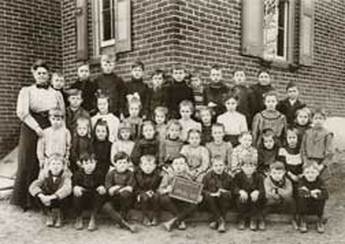The Macungie Institute
Macungie School

Macungie School - 1908; Miss Annie Griffin, Primary Teacher
Millerstown's first free public school was established in 1840, when a stone building was purchased at 28 North Church Street. The structure was enlarged, and a cupola housing a bell was placed on the roof. James Christman served as its schoolmaster. Prior to 1840, various town buildings had been used as temporary schoolhouses and teacher salaries were either paid directly by patrons, or were subsidized by the township.
In 1856, realizing the insufficiency of the existing schools, a number of citizens of the Millerstown community organized the Macungie Institute with a capital investment of $1,300 by selling 52 shares of Institute stock at $25 per share. (It should be noted that in the year 1856, what is today the Borough of Macungie was then known as the Village of Millerstown; therefore, the Macungie Institute took the name of the surrounding township, and not that of the village.) A half acre of ground at the eastern end of Main Street was purchased from Joseph Wescoe for $50, and a two-story brick building was erected at a total cost of $1,800. The original stockholders of March 24, 1856, were Aaron Erdman, George Hinckel, Samuel Moyer, Harrison Miller, Charles Foster, John Mattern, James Singmaster, William Wesco, J. Peter Haas, Daniel Rems, Nathan Haas, John Kerchner, Peter Leisenring, Solomon Ohl, Jacob Swenk, Charles Knoush, John Shaffer, Charles Bower, Jonas Christman, and Solomon Gorr. In its constitution, we find that the objective of the Institute was "to promote literature and to stimulate a desire among us for the better instruction of youth in the primary and higher branches of learning; to make fruitful the barren minds of gallant sons and daughters of Lehigh." The school motto was "Learn to tell what you know."
The new Institute opened its doors on November 17, 1856, with 16 pupils. Oliver S. Fell was hired as the Principal. By September 1857, enrollment had increased to 86. Miss Mary A. McGhee was added as Fell's assistant, and Dr. Samuel R. Rittenhouse was retained as a "Lecturer on Hygiene." The Institute taught the common branches of a "complete English education," together with history, geography, philosophy, algebra, and mensuration. A Literary Society was conducted by the students, and Friday afternoons were devoted to spelling bees, recitations, and other entertainment. This brief experiment in private education greatly improved the academic level of the small village, but by 1860 the income of the school was insufficient to meet expenses, and classes were suspended. The building was rented to the public school board for several months, and in 1862 the property was sold to the borough school district for $865.
By 1871, the number of students at the Millerstown public school had increased to the point where an addition of equal size as the original building was built, housing three departments: Primary, Secondary, and Advanced. In the following years other improvements were made to the structure, including the addition of steam heat; however, outside toilets remained an unpleasant feature. Then on August 9, 1939, the Board of Directors of the Macungie School District passed two resolutions dealing with increasing the indebtedness of the district through a public bond issue "to construct, furnish, and equip" a new, modern school building. After holding public meetings to discuss the issue, voters approved the bond issue at municipal elections held on September 12, 1939. The approved amount of indebtedness was $42,000, with an additional $34,000 to be raised through federal grants from the Federal Emergency Administration of Public Works. The contractor, Arthur P. Hauser of Emmaus, began construction during September 1941, and the new school opened its doors to students on September 8, 1942. A public Halloween open house was held on October 16, 1942, and the white letters of "Macungie School" were added to the Main Street auditorium wall during early November.
High school classes continued to be graduated by the Macungie School District through 1919, but by the 1920s, high school age students were being sent to the Jefferson building in Emmaus for their high school education. In 1946, the Emmaus School District, recognizing that a new and larger high school would soon be needed to serve Emmaus and the surrounding communities, initiated discussions with the directors of the Alburtis, Macungie, Lower Macungie, and Upper Milford school districts. In July 1950, four of these boards voted to merge and form a new East Penn Union School District, but Upper Milford deferred their entrance into the union until 1955. On November 6, 1951, the merger was approved by the voters of the four districts, and the new union school district officially began operations on July 7, 1952. As the result of this merger, ownership of the Macungie School was transferred to the new East Penn Union School District. Macungie School continued to serve the elementary students of the community for nearly four more decades, but with the opening of Shoemaker Elementary School in September 1970, and the construction of a new Macungie Elementary School in 1989, the old Macungie School finally closed its doors to classes when the school year ended on June 16, 1989. After nearly 133 years of service to the Macungie community, the old school was relegated to office and, later, storage space by the East Penn School District, until repurchased by the borough in May 2000.
Copyright (c) 2011 by the Macungie Historical Society, Inc. All Rights Reserved.
